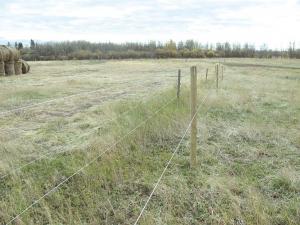2015 - Volume #39, Issue #5, Page #31
[ Sample Stories From This Issue | List of All Stories In This Issue | Print this story
| Read this issue]
3D Fence Deters Wildlife
 |
The design is simple - add a second, one-strand fence outside an existing fence. The key is to have it at a different height than the main fence and about 3 ft. away. Because deer, elk and moose have eyes on the sides of their head, they have poor depth perception. The varying height, depth and width of the fence gives it a 3D effect that confuses them so they’ll go around that field instead of through it.
Electrifying the outside fence makes it even more effective, according to project results from a study by the Peace Country Beef and Forage Association in Alberta, Canada. They tried the 3D concept in a variety of settings and had the best results when electrified.
Though researchers say that electrifying the fence is important, Spirit River, Alberta, farmer Lawrence Andruchiw says he doesn’t think it’s necessary. Just touching the wire trips animals up, he says, and they choose new paths. He went a step farther and placed single wire fences 3 ft. away and 3 ft. off the ground on both sides of part of his existing fence where there was a game trail.
The only time he has had a problem is when a herd of elk hits the fence at once.
The 3D fence can be set up selectively, where there have been wildlife problems or game trails, for example.
For more information, check out the study at www.peaceforage.bc.ca.

Click here to download page story appeared in.

Click here to read entire issue
To read the rest of this story, download this issue below or click here to register with your account number.




